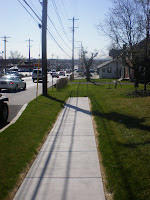Complete streets is a policy of rethinking how we accommodate our citizens in our transportation system. Transportation planning in the United States has been dominated by one entity: the automobile. Since 1956, when the Interstate Highway System was created, planning, designing, construction and use of our nation's roadways have centered around the automobile. After decades of this paradigm, we are awaking to the realization that we have eliminated choice in our transportation system. Roadways have become inhospitable places for pedestrians, bicyclists, and transit riders; all are allowed to use the roadway network, but infrequently they are welcomed. Beyond the lack of choice citizens face, a fundamental flaw has been exposed in our transportation system: the risk to foreign threats as we continue to consume oil.
Complete streets, and the proposed legislation in H.R. 1780, do not remove the automobile from transportation planning. A complete streets policy will require that states must include pedestrians, bicyclists and transit users in the planning process when designing a roadway improvement project. Through changing the demands on our planners and designers we will be able to offer more choices to the system's users, often with positive benefits. Providing a safe, welcoming environment for all citizens to make the best transportation choice is paramount in a complete streets policy. For short trips, close to home or office, walking or bicycling are often the most economical choice, but current roadway design makes these choices often the most risky.
Complete streets have a wider benefit than simply offering more choice to citizens, it is an effective way to reduce congestion, limit our nation's dependence on foreign oil, improve air quality, and combat the obesity epidemic. Through proper roadway design, the costs of including safe amenities for bicyclists, pedestrians, and transit riders will be offset and paid for by the individual savings of each user. H.R. 1780 is an excellent step in addressing these concerns, however it does so with caution.
A Complete Streets Policy, as what would be required under H.R.1780, does not require that amenities are to be included indiscriminately. In places where bicycles and pedestrians are prohibited by law, typically limited access highways, amenities would not be required. In places where it has been determined that the volume of traffic and/or the volume of foot traffic is extremely low, typical in rural areas, amenities would not be required either. The intent of Complete Streets is to improve our transportation system, not add unnecessary costs to projects where the need and benefit is diminutive.

 Thursday, July 28, 2011
Thursday, July 28, 2011
 Shayne Trimbell
Shayne Trimbell


 Posted in:
Posted in: 




0 comments:
Post a Comment